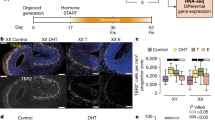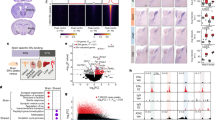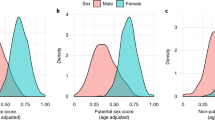Abstract
Understanding the mechanisms that give rise to sex differences in the behavior of nonhuman animals may contribute to the understanding of sex differences in humans. In vertebrate model systems, a single factor—the steroid hormone testosterone—accounts for most, and perhaps all, of the known sex differences in neural structure and behavior. Here we review some of the events triggered by testosterone that masculinize the developing and adult nervous system, promote male behaviors and suppress female behaviors. Testosterone often sculpts the developing nervous system by inhibiting or exacerbating cell death and/or by modulating the formation and elimination of synapses. Experience, too, can interact with testosterone to enhance or diminish its effects on the central nervous system. However, more work is needed to uncover the particular cells and specific genes on which testosterone acts to initiate these events.
This is a preview of subscription content, access via your institution
Access options
Subscribe to this journal
Receive 12 print issues and online access
$209.00 per year
only $17.42 per issue
Buy this article
- Purchase on Springer Link
- Instant access to full article PDF
Prices may be subject to local taxes which are calculated during checkout


Debbie Maizels

Debbie Maizels

Debbie Maizels
Similar content being viewed by others
References
Wilson, J.D. The role of androgens in male gender role behavior. Endocrine Rev. 20, 726–737 (1999).
Phoenix, C.H., Goy, R.W., Gerall, A.A. & Young, W.C. Organizing action of prenatally administered testosterone propionate on the tissues mediating mating behavior in the female guinea pig. Endocrinology 65, 369–82 (1959).
Meisel, R.L. & Sachs, B.D. The physiology of male sexual behavior. in The Physiology of Reproduction Edn. 2 (eds. Knobil, E. & Neill, J.D.) 3–105 (Raven Press, New York, 1994).
Dejonge, F.H. et al. Lesions of the Sdn-Poa inhibit sexual behavior of male Wistar rats. Brain Res. Bull. 23, 483–492 (1989).
Dohler, K.D. et al. Prenatal and postnatal influence of testosterone propionate and diethylstilbestrol on differentiation of the sexually dimorphic nucleus of the preoptic area in male and female rats. Brain Res. 302, 291–295 (1984).
Davis, E.C., Popper, P. & Gorski, R.A. The role of apoptosis in sexual differentiation of the rat sexually dimorphic nucleus of the preoptic area. Brain Res. 734, 10–18 (1996).
Gorski, R.A., Gordon, J.H., Shryne, J.E. & Southam, A.M. Evidence for a morphological sex difference within medial preoptic area of rat-brain. Brain Res. 148, 333–346 (1978).
Park, J.J., Tobet, S.A. & Baum, M.J. Cell death in the sexually dimorphic dorsal preoptic area anterior hypothalamus of perinatal male and female ferrets. J. Neurobiol. 34, 242–252 (1998).
Young, J.K. A comparison of hypothalami of rats and mice: lack of gross sexual dimorphism in the mouse. Brain Res. 239, 233–239 (1982).
Shah, N.M. et al. Visualizing sexual dimorphism in the brain. Neuron 43, 313–319 (2004).
Simerly, R.B. Wired for reproduction: organization and development of sexually dimorphic circuits in the mammalian forebrain. Annu. Rev. Neurosci. 25, 507–536 (2002).
Breedlove, S.M. & Arnold, A.P. Hormone accumulation in a sexually dimorphic motor nucleus of the rat spinal-cord. Science 210, 564–566 (1980).
Forger, N.G. & Breedlove, S.M. Sexual dimorphism in human and canine spinal-cord: role of early androgen. Proc. Natl. Acad. Sci. USA 83, 7527–7531 (1986).
Holmes, M.M. & Wade, J. Characterization of projections from a sexually dimorphic motor nucleus in the spinal cord of adult green anoles. J. Comp. Neurol. 471, 180–187 (2004).
Cihak, R., Gutmann, E. & Hanzliko, V. Involution and hormone-induced persistence of M sphincter-(levator)-ani in female rats. J. Anat. 106, 93–110 (1970).
Nordeen, E.J., Nordeen, K.W., Sengelaub, D.R. & Arnold, A.P. Androgens prevent normally occurring cell-death in a sexually dimorphic spinal nucleus. Science 229, 671–673 (1985).
Freeman, L.M., Watson, N.V. & Breedlove, S.M. Androgen spares androgen-insensitive motoneurons from apoptosis in the spinal nucleus of the bulbocavernosus in rats. Horm. Behav. 30, 424–433 (1996).
Ibanez, M.A., Gu, G.B. & Simerly, R.B. Target-dependent sexual differentiation of a limbic-hypothalamic neural pathway. J. Neurosci. 21, 5652–5659 (2001).
Zup, S.L. et al. Overexpression of Bcl-2 reduces sex differences in neuron number in the brain and spinal cord. J. Neurosci. 23, 2357–2362 (2003).
Young, L.J. & Wang, Z. The neurobiology of pair bonding. Nat. Neurosci. 7, 1048–1054 (2004).
Zhou, L., Blaustein, J.D. & Devries, G.J. Distribution of androgen receptor immunoreactivity in vasopressin-immunoreactive and oxytocin-immunoreactive neurons in the male rat brain. Endocrinology 134, 2622–2627 (1994).
Cooke, B.M., Tabibnia, G. & Breedlove, S.M. A brain sexual dimorphism controlled by adult circulating androgens. Proc. Natl. Acad. Sci. USA 96, 7538–7540 (1999).
Morris, J.A., Jordan, C.L. & Breedlove, S.M. Medial amygdala volume is sexually dimorphic in mice. Horm. Behav. 44, 65 (2003).
Cooke, B.M., Breedlove, S.M. & Jordan, C.L. Both estrogen receptors and androgen receptors contribute to testosterone-induced changes in the morphology of the medial amygdala and sexual arousal in male rats. Horm. Behav. 43, 336–346 (2003).
Breedlove, S.M. & Arnold, A.P. Sexually dimorphic motor nucleus in the rat lumbar spinal cord: response to adult hormone manipulation, absence in androgen-insensitive rats. Brain Res. 225, 297–307 (1981).
Watson, N.V., Freeman, L.M. & Breedlove, S.M. Neuronal size in the spinal nucleus of the bulbocavernosus: direct modulation by androgen in rats with mosaic androgen insensitivity. J. Neurosci. 21, 1062–1066 (2001).
Forger, N.G., Fishman, R.B. & Breedlove, S.M. Differential effects of testosterone metabolites upon the size of sexually dimorphic motoneurons in adulthood. Horm. Behav. 26, 204–213 (1992).
Hegstrom, C.D., Jordan, C.L. & Breedlove, S.M. Photoperiod and androgens act independently to induce spinal nucleus of the bulbocavernosus neuromuscular plasticity in the Siberian hamster, Phodopus sungorus. J. Neuroendocrinol. 14, 368–374 (2002).
Cooke, B.M., Hegstrom, C.D., Keen, A. & Breedlove, S.M. Photoperiod and social cues influence the medial amygdala but not the bed nucleus of the stria terminalis in the Siberian hamster. Neurosci. Lett. 312, 9–12 (2001).
Cooke, B.M., Hegstrom, C.D. & Breedlove, S.M. Photoperiod-dependent response to androgen in the medial amygdala of the Siberian hamster, Phodopus sungorus. J. Biol. Rhythms 17, 147–154 (2002).
Nottebohm, F. & Arnold, A.P. Sexual dimorphism in vocal control areas of songbird brain. Science 194, 211–213 (1976).
Nottebohm, F. Testosterone triggers growth of brain vocal control nuclei in adult female canaries. Brain Res. 189, 429–436 (1980).
Paton, J.A. & Nottebohm, F.N. Neurons generated in the adult brain are recruited into functional circuits. Science 225, 1046–1048 (1984).
Arnold, A.P. The effects of castration and androgen replacement on song, courtship, and aggression in zebra finches (Poephila guttata). J. Exp. Zool. 191, 309–26 (1975).
Gurney, M.E. Hormonal control of cell form and number in the zebra finch song system. J. Neurosci. 1, 658–673 (1981).
Konishi, M. & Akutagawa, E. Hormonal control of cell death in a sexually dimorphic song nucleus in the zebra finch. Ciba Found. Symp. 126, 173–85 (1987).
Arnold, A.P., Wade, J., Grisham, W., Jacobs, E.C. & Campagnoni, A.T. Sexual differentiation of the brain in songbirds. Devel. Neurosci. 18, 124–136 (1996).
Arnold, A.P. Genetically triggered sexual differentiation of brain and behavior. Horm. Behav. 30, 495–505 (1996).
Holloway, C.C. & Clayton, D.F. Estrogen synthesis in the male brain triggers development of the avian song control pathway in vitro. Nat. Neurosci. 4, 170–5 (2001).
Agate, R.J. et al. Neural, not gonadal, origin of brain sex differences in a gynandromorphic finch. Proc. Natl. Acad. Sci. USA 100, 4873–4878 (2003).
Arnold, A.P. et al. Minireview: sex chromosomes and brain sexual differentiation. Endocrinology 145, 1057–1062 (2004).
Wagner, C.K. et al. Neonatal mice possessing an Sry transgene show a masculinized pattern of progesterone receptor expression in the brain independent of sex chromosome status. Endocrinology 145, 1046–1049 (2004).
De Vries, G.J. et al. A model system for study of sex chromosome effects on sexually dimorphic neural and behavioral traits. J. Neurosci. 22, 9005–9014 (2002).
Brenowitz, E.A. & Lent, K. Act locally and think globally: intracerebral testosterone implants induce seasonal-like growth of adult avian song control circuits. Proc. Natl. Acad. Sci. USA 99, 12421–12426 (2002).
Grisham, W., Mathews, G.A. & Arnold, A.P. Local intracerebral implants of estrogen masculinize some aspects of the zebra finch song system. J. Neurobiol. 25, 185–196 (1994).
Monks, D.A., Vanston, C.M. & Watson, N.V. Direct androgenic regulation of calcitonin gene-related peptide expression in motoneurons of rats with mosaic androgen insensitivity. J. Neurosci. 19, 5597–5601 (1999).
Forger, N.G., Roberts, S.L., Wong, V. & Breedlove, S.M. Ciliary neurotrophic factor maintains motoneurons and their target muscles in developing rats. J. Neurosci. 13, 4720–4726 (1993).
Forger, N.G., Wong, V. & Breedlove, S.M. Ciliary neurotrophic factor arrests muscle and motoneuron degeneration in androgen-insensitive rats. J. Neurobiol. 28, 354–362 (1995).
Xu, J., Gingras, K.M., Bengston, L., Di Marco, A. & Forger, N.G. Blockade of endogenous neurotrophic factors prevents the androgenic rescue of rat spinal motoneurons. J. Neurosci. 21, 4366–4372 (2001).
Forger, N.G. et al. Sexual dimorphism in the spinal cord is absent in mice lacking the ciliary neurotrophic factor receptor. J. Neurosci. 17, 9605–9612 (1997).
Forger, N.G. et al. Cardiotrophin-like cytokine/cytokine-like factor 1 is an essential trophic factor for lumbar and facial motoneurons in vivo. J. Neurosci. 23, 8854–8858 (2003).
Amateau, S.K. & McCarthy, M.M. Induction of PGE2 by estradiol mediates developmental masculinization of sex behavior. Nat. Neurosci. 7, 643–650 (2004).
Amateau, S.K. & McCarthy, M.M. A novel mechanism of dendritic spine plasticity involving estradiol induction of prostaglandin-E2. J. Neurosci. 22, 8586–8596 (2002).
Berenbaum, S.A. Effects of early androgens on sex-typed activities and interests in adolescents with congenital adrenal hyperplasia. Horm. Behav. 35, 102–110 (1999).
Hines, M., Brook, C. & Conway, G.S. Androgen and psychosexual development: core gender identity, sexual orientation and recalled childhood gender role behavior in women and men with congenital adrenal hyperplasia (CAH). J. Sex Res. 41, 75–81 (2004).
Money, J., Ehrhardt, A.A. & Masica, D.N. Fetal feminization induced by androgen insensitivity in the testicular feminizing syndrome: effect on marriage and maternalism. Johns Hopkins Med. J. 123, 105–114 (1968).
Wisniewski, A.B. et al. Complete androgen insensitivity syndrome: long-term medical, surgical, and psychosexual outcome. J. Clin. Endocrinol. Metab. 85, 2664–2669 (2000).
Rahman, Q., Kumari, V. & Wilson, G.D. Sexual orientation-related differences in prepulse inhibition of the human startle response. Behav. Neurosci. 117, 1096–1102 (2003).
McFadden, D. & Pasanen, E.G. Comparison of the auditory systems of heterosexuals and homosexuals: Click-evoked otoacoustic emissions. Proc. Natl. Acad. Sci. USA 95, 2709–2713 (1998).
Williams, T.J. et al. Finger-length ratios and sexual orientation. Nature 404, 455–456 (2000).
Martin, J.T. & Nguyen, D.H. Anthropometric analysis of homosexuals and hetero-sexuals: implications for early hormone exposure. Horm. Behav. 45, 31–39 (2004).
LeVay, S. A difference in hypothalamic structure between heterosexual and homosexual men. Science 253, 1034–1037 (1991).
Roselli, C.E., Larkin, K., Resko, J.A., Stellflug, J.N. & Stormshak, F. The volume of a sexually dimorphic nucleus in the ovine medial preoptic area/anterior hypo-thalamus varies with sexual partner preference. Endocrinology 145, 478–483 (2004).
Author information
Authors and Affiliations
Corresponding author
Ethics declarations
Competing interests
The authors declare no competing financial interests.
Rights and permissions
About this article
Cite this article
Morris, J., Jordan, C. & Breedlove, S. Sexual differentiation of the vertebrate nervous system. Nat Neurosci 7, 1034–1039 (2004). https://doi.org/10.1038/nn1325
Received:
Accepted:
Published:
Issue Date:
DOI: https://doi.org/10.1038/nn1325
This article is cited by
-
Sex differences in energy metabolism: natural selection, mechanisms and consequences
Nature Reviews Nephrology (2024)
-
Activin is a neural inducer of a male-specific muscle in Drosophila
Scientific Reports (2024)
-
Comparing a common clavicle maturation-based age estimation method to ordinary regression analyses with quadratic and sex-specific interaction terms in adolescents
Scientific Reports (2024)
-
Sex differences in learning and performing the Go/NoGo tasks
Biology of Sex Differences (2023)
-
Translational profiling identifies sex-specific metabolic and epigenetic reprogramming of cortical microglia/macrophages in APPPS1-21 mice with an antibiotic-perturbed-microbiome
Molecular Neurodegeneration (2023)



